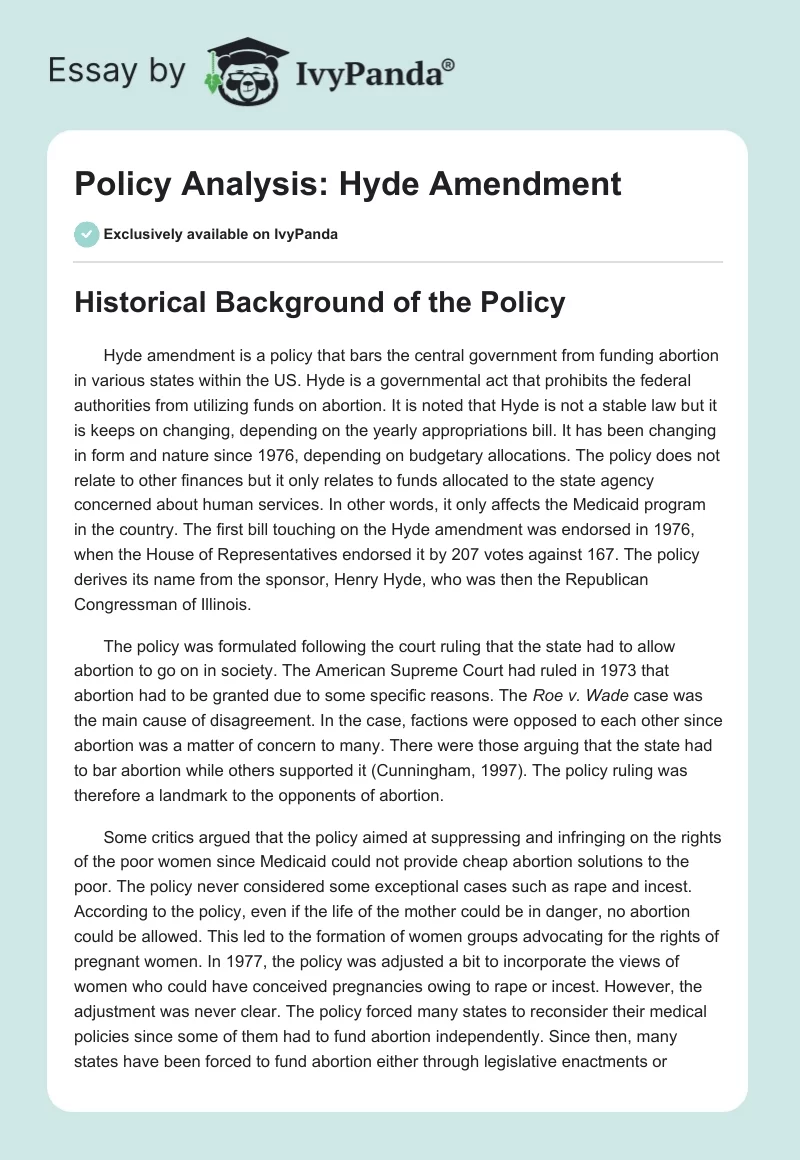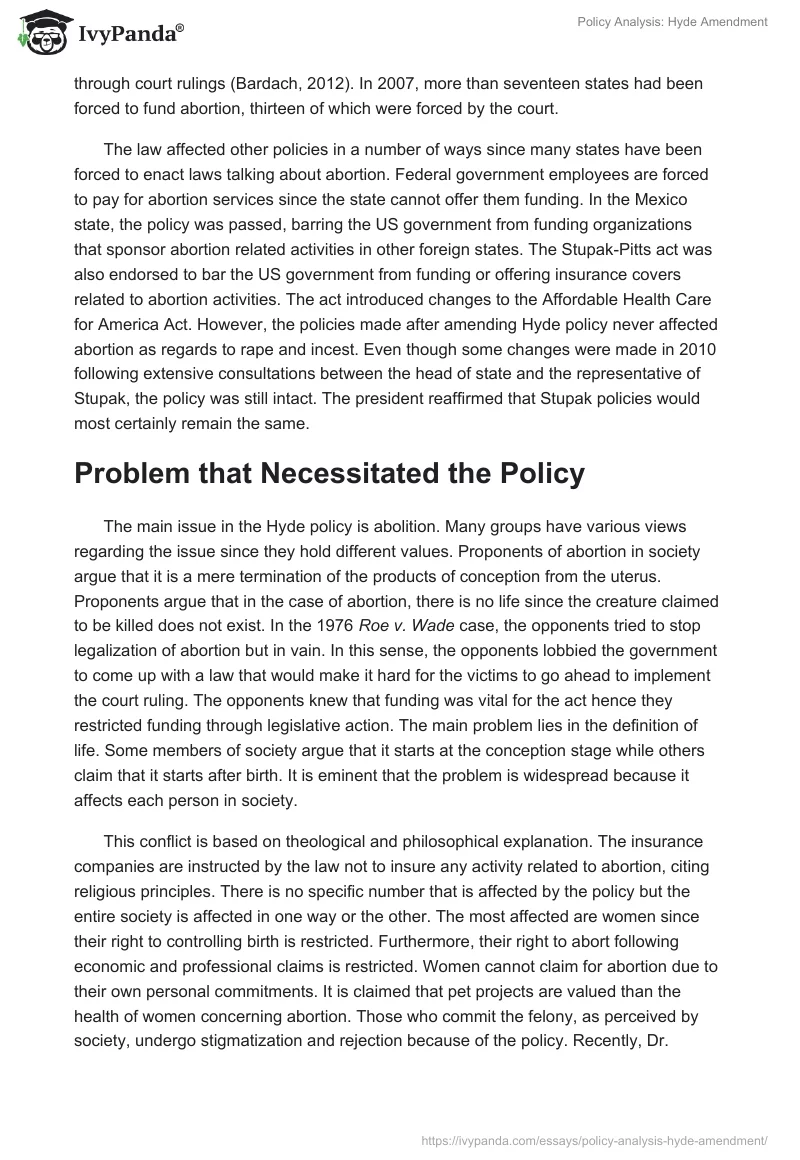Historical Background of the Policy
Hyde amendment is a policy that bars the central government from funding abortion in various states within the US. Hyde is a governmental act that prohibits the federal authorities from utilizing funds on abortion. It is noted that Hyde is not a stable law but it is keeps on changing, depending on the yearly appropriations bill. It has been changing in form and nature since 1976, depending on budgetary allocations. The policy does not relate to other finances but it only relates to funds allocated to the state agency concerned about human services. In other words, it only affects the Medicaid program in the country. The first bill touching on the Hyde amendment was endorsed in 1976, when the House of Representatives endorsed it by 207 votes against 167. The policy derives its name from the sponsor, Henry Hyde, who was then the Republican Congressman of Illinois.
The policy was formulated following the court ruling that the state had to allow abortion to go on in society. The American Supreme Court had ruled in 1973 that abortion had to be granted due to some specific reasons. The Roe v. Wade case was the main cause of disagreement. In the case, factions were opposed to each other since abortion was a matter of concern to many. There were those arguing that the state had to bar abortion while others supported it (Cunningham, 1997). The policy ruling was therefore a landmark to the opponents of abortion.
Some critics argued that the policy aimed at suppressing and infringing on the rights of the poor women since Medicaid could not provide cheap abortion solutions to the poor. The policy never considered some exceptional cases such as rape and incest. According to the policy, even if the life of the mother could be in danger, no abortion could be allowed. This led to the formation of women groups advocating for the rights of pregnant women. In 1977, the policy was adjusted a bit to incorporate the views of women who could have conceived pregnancies owing to rape or incest. However, the adjustment was never clear. The policy forced many states to reconsider their medical policies since some of them had to fund abortion independently. Since then, many states have been forced to fund abortion either through legislative enactments or through court rulings (Bardach, 2012). In 2007, more than seventeen states had been forced to fund abortion, thirteen of which were forced by the court.
The law affected other policies in a number of ways since many states have been forced to enact laws talking about abortion. Federal government employees are forced to pay for abortion services since the state cannot offer them funding. In the Mexico state, the policy was passed, barring the US government from funding organizations that sponsor abortion related activities in other foreign states. The Stupak-Pitts act was also endorsed to bar the US government from funding or offering insurance covers related to abortion activities. The act introduced changes to the Affordable Health Care for America Act. However, the policies made after amending Hyde policy never affected abortion as regards to rape and incest. Even though some changes were made in 2010 following extensive consultations between the head of state and the representative of Stupak, the policy was still intact. The president reaffirmed that Stupak policies would most certainly remain the same.
Problem that Necessitated the Policy
The main issue in the Hyde policy is abolition. Many groups have various views regarding the issue since they hold different values. Proponents of abortion in society argue that it is a mere termination of the products of conception from the uterus. Proponents argue that in the case of abortion, there is no life since the creature claimed to be killed does not exist. In the 1976 Roe v. Wade case, the opponents tried to stop legalization of abortion but in vain. In this sense, the opponents lobbied the government to come up with a law that would make it hard for the victims to go ahead to implement the court ruling. The opponents knew that funding was vital for the act hence they restricted funding through legislative action. The main problem lies in the definition of life. Some members of society argue that it starts at the conception stage while others claim that it starts after birth. It is eminent that the problem is widespread because it affects each person in society.
This conflict is based on theological and philosophical explanation. The insurance companies are instructed by the law not to insure any activity related to abortion, citing religious principles. There is no specific number that is affected by the policy but the entire society is affected in one way or the other. The most affected are women since their right to controlling birth is restricted. Furthermore, their right to abort following economic and professional claims is restricted. Women cannot claim for abortion due to their own personal commitments. It is claimed that pet projects are valued than the health of women concerning abortion. Those who commit the felony, as perceived by society, undergo stigmatization and rejection because of the policy. Recently, Dr. George Tiller was murdered for assisting a woman to abort, meaning that the medical fraternity is also affected (Munger, 2000).
Abortion is a problem in society that is caused by a number of reasons. One of them is due to crime such as rape. An individual decides to get rid of the fetus because she cannot raise the child alone. It is understood that single parenthood is usually a challenge that many Americans try as much as possible to avoid. Another reason is incest whereby a member of family may accidentally impregnate another female member of the family. This is considered a taboo that should never be allowed to go on in society. Abortion is usually chosen as the best option owing to the many problems brought about incest. Another cause of abortion is professional commitments whereby an individual decides to do away with a pregnancy in order to pursue education (Roberta, 2009). Finally, people abort due to health reasons. The health of the mother may perhaps be in danger, which would force the mother to do away with the fetus. All these are against the wishes and interests of the majority in society, especially the faithful.
Policy Description
In the new version of the Hyde policy, federal Medicaid finances could only be used in cases of rape, incest, and when the life of the mother is in danger. States are to provide additional funds to help in the implementation of the policy. In case a particular state decides to seek for medical insurance cover related to abortion, it must pay for the whole amount. The central government does not take part in the payment of any treatment service related to abortion. In 1980, there was a breakthrough since the Supreme Court identified that the Hyde amendment never went against the federal constitution. However, some judges (four) went against the law claiming that the policy violates the rights of poor women. In the constitution, women are entitled to free Medicare meaning that they should be allowed to abort in case their financial status or health is in danger. Specifically, the law seems to target the poor in society since deprived individuals are incapable of providing basic needs to their loved ones. This means they would not afford abortion.
By the end of 2010, many states never allowed their finances to be utilized in executing abortion, mainly because of the existence of the Hyde amendment. Some states, such as South Dakota utilize their state funds to finance abortion under special circumstances. Some other states referred to as Hyde-Plus have formulated policies to define the Hyde amendment by adding fetal irregularities. Seventeen states in the US fund abortion using their state revenues. While only four do it voluntarily, the rest do so mainly because of the court order.
Policy Analysis
Statistics show that the majority of Americans conceive pregnancies unintentionally meaning that they have to undertake abortion at least once in their lifetime. In 2005 for instance, there were 1.21 million cases of reported abortion. It is surprising that the Medicaid does not cover abortion cases. For instance, women are forced to carry unwanted pregnancies since they do not have an option. Women are required to finance abortions, which is a very expensive undertaking that cannot be executed by black women and women of color. Furthermore, the policy has led to other serious crimes since women attempt to abort using unscrupulous means, which might be very dangerous. Some women are forced to indulge in drugs and other forms of crimes in order to cater for their children who might have been acquired through rape and incest (Stone, 2002). The policy has also limited the activities of nongovernmental organizations since cases are many to an extent that such non-profit making clinics cannot handle.
Even though the policy has been effective in safeguarding state funds, abortion rates have not been affected in any way. Many abortions take place among the low class members of society. The government does not realize its aim, which is to curtail abortion in society. In fact, Guttmacher Institute claims that over 30% of all abortions take place in the slums. While abortion rates decrease among the rich in society, it tends to increase among the poor mainly because of the economic standards. The gap between the rich and the poor is ever increasing in society, which seems to affect abortion rates. In the 1990s, the government came up with other policies such as the personal Responsibility and Work Opportunity Act and the Temporary Assistance for Needy Families block Program, which increased abortion rates in society. It is true that the Hyde amendment has not been effective in preventing abortion in society. It is also true that it has been able to safeguard state funds but has not been able to achieve its long-term goals.
References
Bardach, E. (2012). A practical guide for policy analysis: the eightfold path to more effective problem solving (4th ed.). Washington, D.C.: CQ Press.
Cunningham, G. (1997). Williams Obstetrics (20th ed.). New York: Wiley & Sons.
Munger, M. (2000). Analyzing policy: choices, conflicts, and practices (1st ed.). New York: W.W. Norton.
Roberta, W. (2009). Equal Rights Amendment. New York: Alice Paul Institute.
Stone, D. A. (2002). Policy paradox: the art of political decision-making. New York: Norton.


